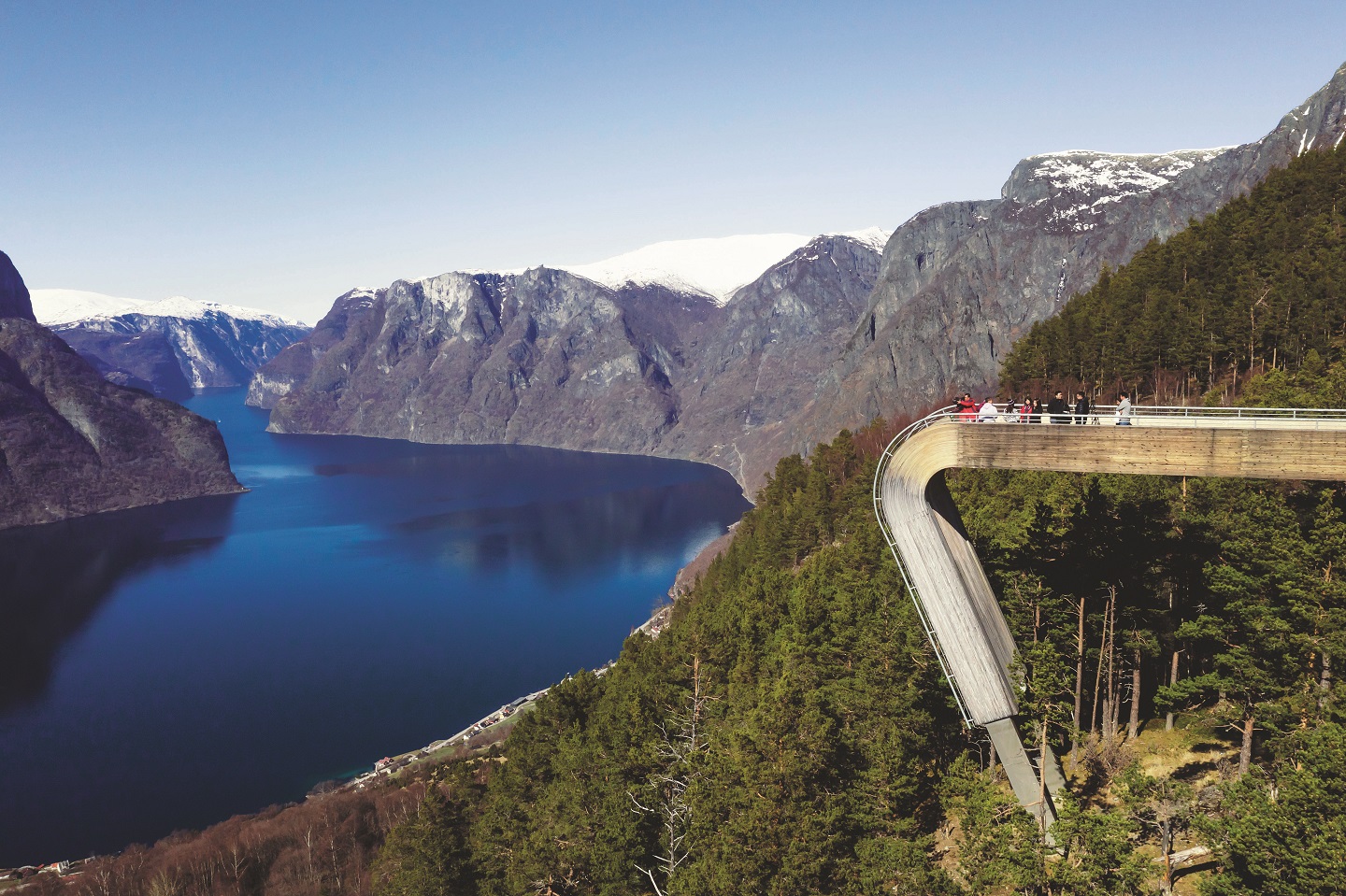
The Stegastein, a viewing platform that juts out 30m from steep mountain walls (Photo: Marius Fiskum)
The Stegastein, a viewing platform that juts out 30m from steep mountain walls, was so eerily silent we could hear our hearts beat. The wind howled through the perfectly still Aurlandsfjord 650m below, rustling the trees in its path and bristling the hairs on our arms. We tried steadying our fingers on the camera shutter button in the frigid cold but soon realised that no photo or written poetry about this land of Norse legend could prepare anyone for the vista before us.
Norway’s fjords — long, deep and narrow bays formed by glacial erosion that can reach more than a hundred miles — are commonly enjoyed from the decks of cruise ships that skim the waters north of Bergen, the country’s second largest city, where Viking roots are entrenched.
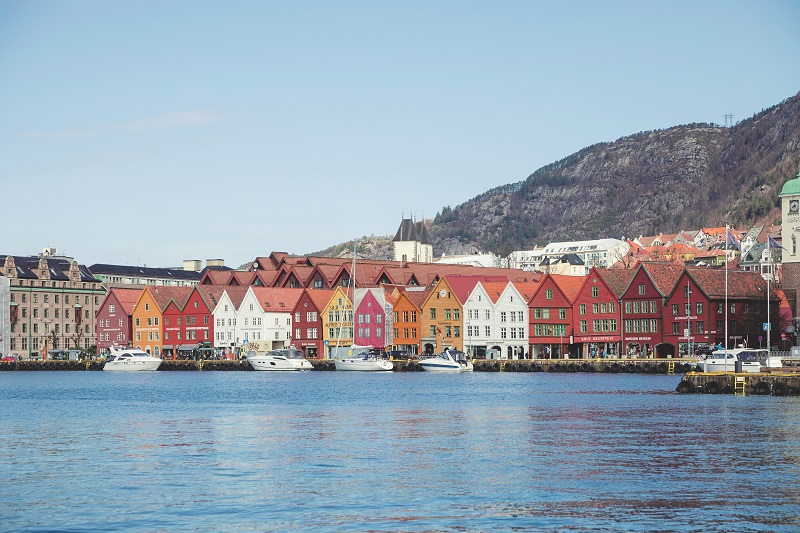
But for hikers willing to scale mountain peaks, a dramatic landscape of paradisiacal beauty awaits. We could not work out what took our breath away more: studying the ragged cliffs plastered in snow and plunging ravines engineered by nature, or fighting off squawking, potato chip-stealing gulls.
There are many ways to get to the fjords, including a 20km ride via the Flåm (pronounced “flōm”) Railway, one of the world’s steepest tracks with an altitude difference of 866m. Also known as Flåmsbana, the track is part of the Bergen Railway, which traverses two big cities, Bergen and Oslo. Crossing 20 tunnels, 18 of which are built by hand, the journey ends at the quaint village of Flåm, where you can then embark on a cruise to the Unesco World Heritage-listed Nærøyfjord, the narrowest fjord in the world.
Poking our faces outside the window for some cool breezes, we were soothed by the rhythmic clacking of the retro train, pacing steadily through the mountain plateau at Myrdal to snowy terrains littered with 17th-century wooden churches and remote red farmhouses marooned on the crook of a hill. The scenery along the way, bookended by gushing waterfalls like the Kjosfossen and Rjoandefossen, alternated between the wintry and the verdant, which flickered by like photos screened on a beat-up projector.
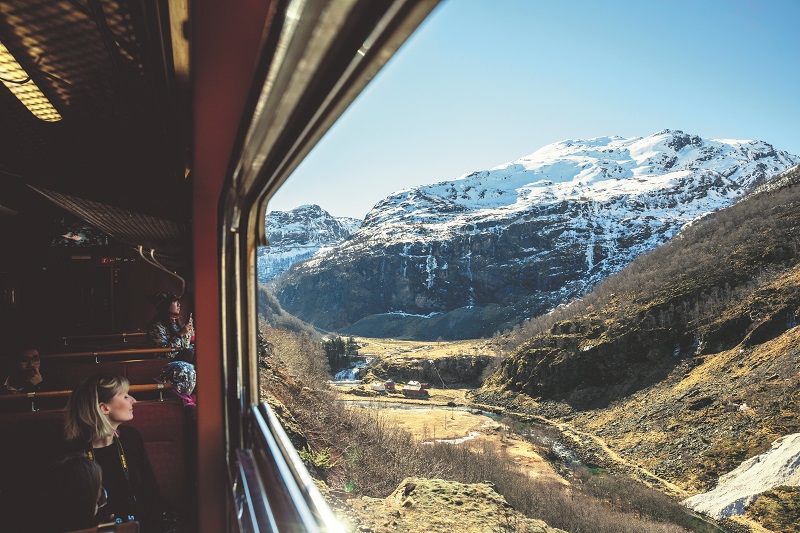
Fjords are the fingerprints of Norway’s metaphorical DNA, partly because Norwegians structure their lives around the bounty they harvest from these glacial waters. Inveterate seafood lovers travelling to this Scandinavian nation — with one of the most undulatory coastlines in the world — usually hunt for enormous, reddish king crab with gangly legs, plump scallops the size of macarons, oysters swimming in their briny liqueur and the assertively flavoured salmon. But a different local pride has been fishing for attention in Asian markets, especially in Malaysia — fjord trout.
Jewels of the Norwegian fjords
Visiting Norway without a raging appetite for seafood would be a near-sacrilegious waste. With a geography inescapably fixed on the sea, Norway is the second largest exporter of fish in the world, and seafood is the country’s second most valuable export after oil. The reputation of Norwegian seafood in Malaysia is well-earned. To put things into perspective, the total import of Norwegian salmon and fjord trout to Malaysia in 2018 was valued at 240 million Norwegian krone (RM115 million), an increase in export value of 10% compared with 2017.
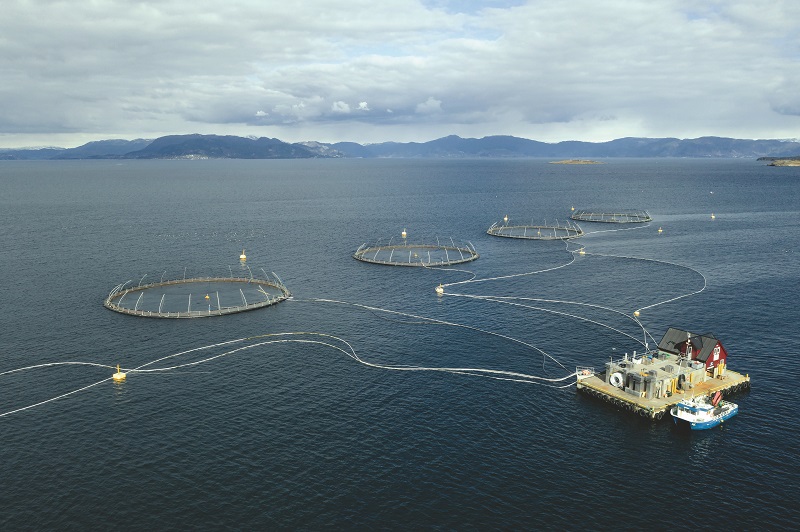
Once a rarity on our local dining tables, fjord trout is gaining popularity because of its florid red-orange flesh; a big draw among Malaysians who associate colour with freshness. This is not to say that the paler-hued salmon is of inferior quality — they are just two different types of fish. The nutritious diet of trout causes the flesh to contain more astaxanthin, a natural oxycarotenoid that lends the fish its bright, distinctive pigment.
Discerning consumers are fretting these days over the fuzzy definition of trout as supermarkets and restaurants continue to mislabel them as salmon, or worse, salmon-trout. A technique that greatly simplifies the process of identifying would be to aim for the head. A trout’s head is rounder than the sharper one of the salmon. Thickset with flesh, the former sports a fatter belly, with black spots dotting its silver-coloured body. And unlike river trout, it does not have the trademark earth and muddy taste.
An exacting demand for salmon and trout all-year-round far outpaces the supply of wild fishery, which led to the pioneering practice of salmon farming in the 1970s. The success of Norway’s aquaculture industry, coupled with its expertise in marine biology and technology to ensure food safety and a healthy sea ecosystem, gave rise to trout farming too, which thrives in the pristine condition of clear and cold fjord waters.
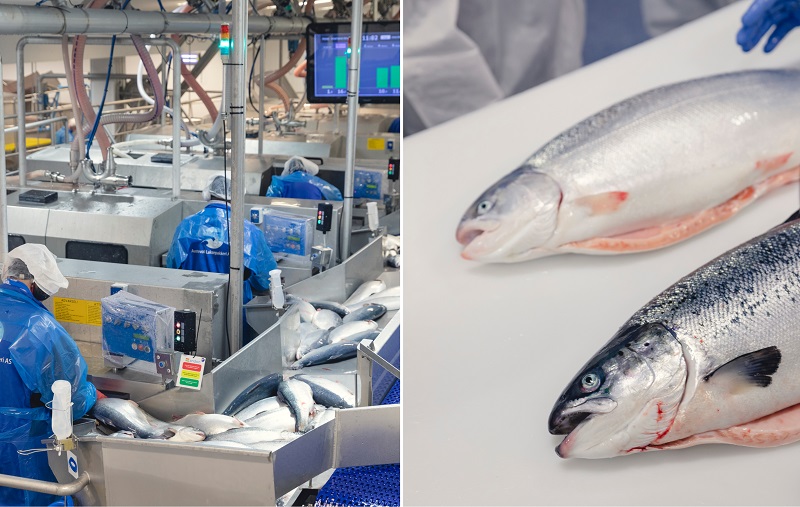
Environmentalists, who seek organic eligibility, have baulked at the idea of farmed fish, which in some cases are raised on unnatural diets in crowded enclosures that can breed disease, prompting operators to rely heavily on antibiotics. But a trip to the trout farm owned by Leroy Seafood Group, a global seafood supplier based in Bergen, proved that strict food safety — such as the detection of undesirable substances like polychlorinated biphenyls, dioxins and heavy metals, and the regulated use of medication to curb diseases — is of paramount importance. Every step, from delivering fish food via pipes from the big tanks to checking the cage temperature for abnormal feeding behaviour, is monitored through CCTV by an employee toggling a remote control that looks uncannily like a gaming joystick.
Like their wild siblings, farm-raised trout are spawned in fresh water before maturing in untainted, saltwater fjords, where the confluence of Arctic sea water and meltwater from glaciers ensures optimal living conditions. At the juvenile farm facility, young trout are given feed that consists of fish oil, fish meal, vitamins and vegetable-based nutrients before they are large enough to be transferred to spacious ocean pens, each covered in wire mesh with a circumference of up to 200m and a depth of up to 50m.Trout living in a body of water where rapid-moving currents constantly provide fresh water to flush away waste, take two to three years to grow to a weight of 4kg to 5kg before they are harvested.
Hot to trout
Nothing can impart quite the same sense of warmth like a bowl of soup. The science behind this incontrovertible comfort is simple — it’s a great ally during winter, the culinary equivalent of a versatile black dress, and it hugs you like a well-knitted sweater. So imagine our delight when we were served a creamy chowder — buttressed with chunks of salmon and cod, as well as a riot of roots and vegetables — for our first meal at Fjellskål Fisk & Skalldyr restaurant in Bergen. A squeeze of lemon juice lifted the weight off this concentrated yet spirit-raising concoction.
If the flavours of the hearty soup lingered on our mind for days, the ensuing meals surrounding Norway’s prized trout made us sink into a sighing surrender. After days of visiting fjord farms, it only seemed right to revel in the purity of trout at its freshest. At a fish-packing facility, a freshly filleted trout was nestled onto a counter before we reached in with our chopsticks. The verdict was broadcast on the satisfied faces around the table.
Unlike salmon’s softness that melts into velvety richness, raw trout is sparklingly firm yet pliant, with a bit of bite. The first sliver should tell you if you are in for a minute of bliss or soy-sauce lubricated disappointment. That morsel we had sang with clean notes of the sea — it was scarcely imaginable that you would have it any other way.
But there are exceptions, of course.
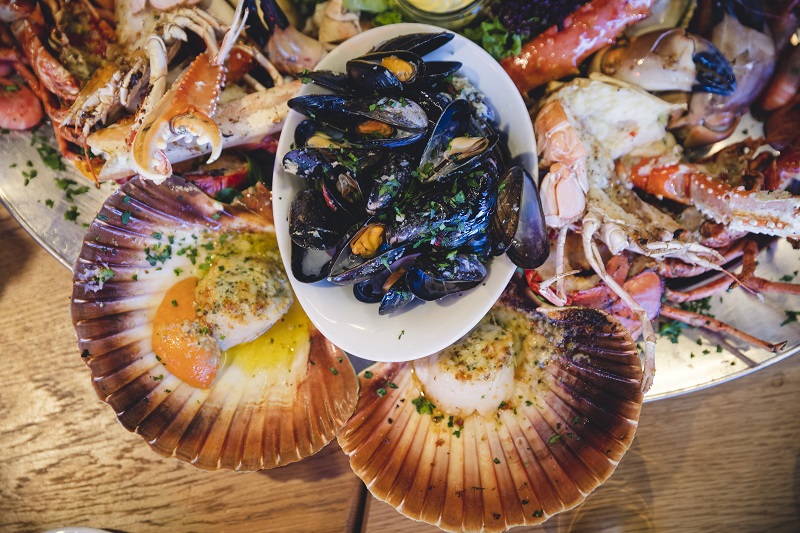
Nordic cuisine exudes an exotic ring, but Norway did not start off with a funky love for smoked food or a goal to return balance to the earth. Traditional Norwegian food, bogged down by a cooking culture that does not travel beyond ingredients like fish, potatoes, flour and milk, errs on the bland side. But evidence of a new Nordic culinary movement is sprouting everywhere as foraged ingredients and artfully ruffled herbs emerge on our plates. This is attributed to a bastion of young blood who are more respectful and mindful of their terroir, including 2015 Bocuse d’Or gold medalist chef Ørjan Johannessen.
Having honed his steely technique since 2007, the 33-year-old trained at Mathuset Solvold in Sandefjord prior to his win at the biennial culinary competition, often considered the Olympics of food. Johannessen’s restaurant in Austevoll, an idyllic island south of Bergen, is a chapel for indulging in the senses. Located next to the country-styled Bekkjarvik Gjestgiveri, a 17th-century hotel managed by his also-chef parents for 32 years, the restaurant creates the impression that you are dining in a tasteful Scandinavian friend’s weekend home.
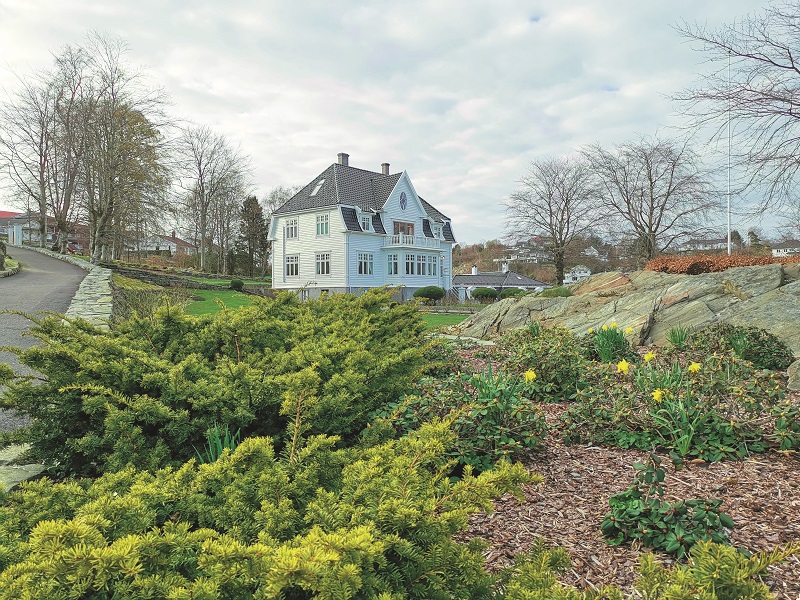
Johannessen’s philosophy hinges on casual simplicity instead of flamboyant embellishments, and the main course he prepared for us shattered any qualms. A slab of perfectly poached fjord trout resting on a bed of fried cabbage stems was given new personality with a few creative strokes. A blob of caramelised onion and Jerusalem artichoke puree teased with sweetness, balancing the fatty qualities of the fish. But it was the sauce that truly showed Johannessen’s felicitous interpretation of fusion. A cloud of crème fraiche, which acquired a surreal green shade from leek oil, was spiked with horseradish and a whiff of yuzu to lend a zippy brightness.
Inventive practices do not always break frontiers, and Johannessen is not planning to. Yet, one will find a confident display of tradition and innovation in his food, which raised the international profile of Norwegian cuisine while honouring its roots. His methods push the edges of familiarity without sending our taste receptors into overdrive, like the trout, which he thought was best poached so the natural juices are all locked in. Well, that makes two of us.
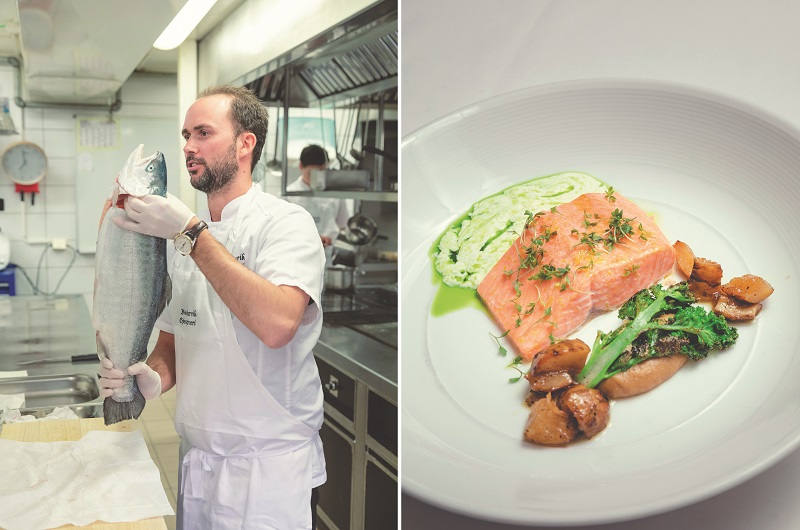
“There’s a very sophisticated way of eating fish in Norway. We don’t buy the whole fish, only portions without skin or bones, perhaps out of convenience. In my opinion, trout is the world’s best red fish. Norwegian trout differs from the kinds in America or Madagascar because of its firmer texture and consistency. You can do so much with it: pickle, poach, pan-fry and even roast on the skin. The possibilities are endless,” says the soft-spoken chef.
Johannessen’s approach to food dovetails with Norway’s larger objective of not skirting around its heritage but to give it a dial-up. It is an attitude shared among the country’s community of farmers, fishermen and artisans too, who deliver experiences that are renewing without diluting the authenticity of their crafts.
After spending time at the fjords, one becomes easily desensitised to their sheer majesty that it is easy to scoff at another sea-and-mountain vista. But this trip reminded us that there is more than just being smitten with the sublime: people here lived, tamed and respected their land, and we too, should reconcile with ours.
This article first appeared on May 6, 2019 in The Edge Malaysia.


